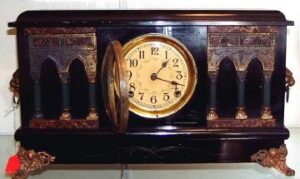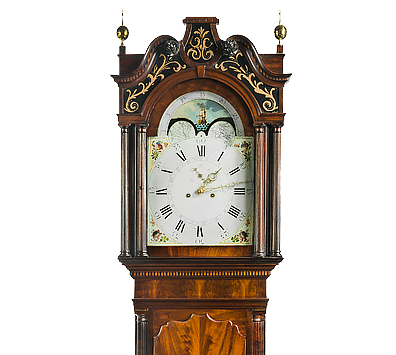Sessions Clock History
The Sessions Clock Company started life in Forestville, Connecticut in 1831 as the Barns and Welch Company when Elisha Niles Welch (1809-1887) and Thomas Barnes, Jr. marketed wooden movement shelf clocks until 1834. Then in 1835, Welch partnered with Jonathan C. Brown’s company and formed The Forestville Manufacturing Company. Just two years later, in 1837, the company declared bankruptcy and operations came to a halt in 1840.
Between 1840 and 1856, J. C. Brown continued to sell his clocks with several different partners and using several names on the labels. Some labels during these years still read ’The Forestville Manufacturing Company’. Others read J.C. Brown or Forestville Hardware and Clock Company. During these tough years Elisha Welch held financial interest in these various companies.
On January 12, 1856, J.C. Brown again declared bankruptcy and the business was purchased by Elisha Niles Welch. In addition, Welch also purchased The Forestville Hardware and Clock Company and the case-making firm of F.S. Otis. He successfully merged these three firms into a profitable clock company during the following several years.
On July 6, 1864, he formed a joint stock corporation, the E.N. Welch Manufacturing Company, for the manufacture and sale of clocks and clock cases.
The E.N. Welch Company

Elisha Welch began the company owning 2,800 shares of stock and was the major stockholder. His son James H. Welch, and two sons-in-law, Andrew Atkins and George Mitchell owned 400 shares each. Elisha also sold his two clock factories and their equipment to the corporation for $29,700. The company became the largest clock producer in the Bristol, Connecticut area as the turn of the century neared.
In 1868, Welch became a partner in a new business venture, the Welch, Spring and Company. This company produced a higher-grade clock that did not sell well even though it was a very fine clock. As a result, the company was absorbed into the E.N. Welch Company in 1884.
Elisha Welch died on August 2, 1887 in Forestville. His son James became president of the company. Poor economic conditions coupled with less than sound management by James caused the company’s financial condition to deteriorate to the point of going into receivership by 1893. The production of clocks ceased until all claims against the company were satisfied. Finally, in 1897, the company resumed operations.
The company finally seemed to have put all its troubles behind and was glad to be stable once again. However, during the years the plant was idle, many of their customers were buying their clocks elsewhere. Once again, in 1898, the company had to borrow money to stay in operation.
Another serious setback happened on March 17, 1899, when a fire that started in the lacquer room of the movement factory destroyed that building and several other buildings around it. Even though much of this loss was not covered by insurance, a new building was quickly built and occupied by October of that year. While waiting for this building, the William L. Gilbert Clock Company was contracted to make movements.
With The Sessions Clock Company back up and running, it may have been possible to regain a viable status but, two months later on December 14, 1899, the case factory was totally destroyed by fire. A modern brick case factory was built and occupied by April, 1900. The money borrowed for this building added to an already critical financial situation.
James Welch died in January of 1902 and later that year, William E. Sessions was elected president of the company and Albert L. Sessions became treasurer. They borrowed money to get the firm back on it’s feet and bought up Welch stock until they were able to take over on January 9, 1903. The new corporate name was ’The Sessions Clock Company’.
The Sessions Clock Company in the Twentieth Century
In the early 1900’s after the Sessions family controlled almost all the stock in the company, they still manufactured the same E.N. Welch line of clocks. You can date early Sessions clocks by the label; if it reads E.N. Welch it was made before 1903; if both E.N. Welch and Sessions Clock Company appear on the label it was made after 1903. The Welch name was gradually phased out as Sessions started making their own line of clocks, and by 1920, they started making higher quality clocks such as regulators, and started phasing out the old style pressed-oak kitchen clocks and black mantel clocks. Trouble arrived again for the Sessions Clock Company in the 1930’s. Of course the depression slowed sales tremendously, but in addition to the economic slow down was the popularity of the ‘new’ synchronous electric clocks that left Sessions with a large inventory of their spring-driven clocks. By 1936, Sessions discontinued the manufacture of spring-driven clocks, and made electric clocks exclusively.
The next interruption came during WWII. All Sessions clock operations stopped early in 1943 so the plant could manufacture war materials. In September of 1945, clock operations resumed.
Heading into the 1950’s, The Sessions Clock Company was again turning a profit by selling cheaply made electric clocks. Most of these were plain looking, plastic alarm clocks, or kitchen wall clocks. The one exception to this lack of innovation was their ’worlds first (and last) family planning clock’ called “The Lady“. It could be set with a woman’s menstrual cycle and show the days of the most or least fertility. The Lady never caught on with the public, so it was discontinued. It was re-introduced years later in the late sixties when it was thought that the public opinion on birth control had changed but it again failed to capture the public’s interest. However, today they are highly collectible if you are lucky enough to find one.
In 1956, the name of the Sessions Clock Company was changed to The Sessions Company. Sales were declining and by 1958, the company posted a loss of more than a million dollars. In 1958, the company was sold to Consolidated Electronics Industries Corporation of New York. They continued to make cheap electric clocks in the Forestville, Connecticut plant. In 1968, as a result of a nine week strike by its workers, the company was sold to United Metal Goods Company of Brooklyn, New York. The new company shut down the Forestville plant, after over 137 years of continuous operation, and sold off the buildings.
The North American Phillips Corporation (Norelco) of Wilmington, Delaware merged with what was left of Sessions in 1969. They were going to manufacture electric control devices and they changed the name to The Session Company. The new company didn’t get sufficient orders and never got off the ground.
The Sessions family did not completely disappear from clock making. W. Kenneth Sessions, Jr., a former board member of The Sessions Company, read the writing on the wall and left the company to form a new firm. The New England Clock Company started production in 1958, in Bristol, Connecticut. With the costs of manufacturing and wages spiraling upwards, Kenneth Sessions built this new business as an assembly and sales business, buying the movements overseas where they could be manufactured at a lower cost. The remainder of the clock parts, such as the dials, hands, cases, and chimes were made to order at other existing plants and brought to Bristol for assembly.

Ship Your Clock for Expert Repairs!
Expert Shipping Instructions!

Grandfather Clock Service Calls
We make Grandfather Clock service calls!

Contact Us
Feel free to contact us any time at (215) 862-2415.

Further Questions?
We'd like to hear from you!
People Say




